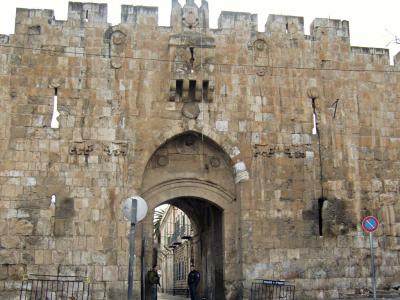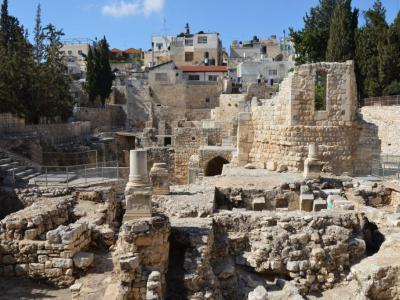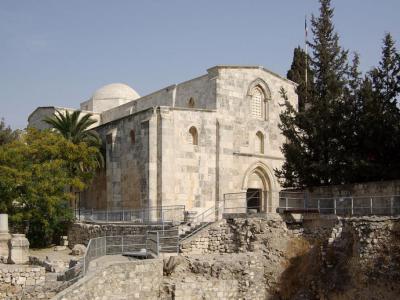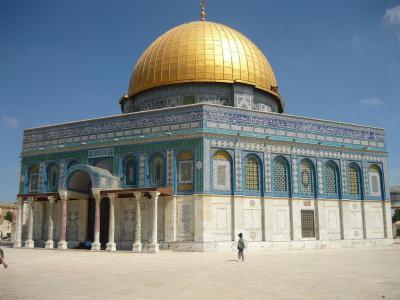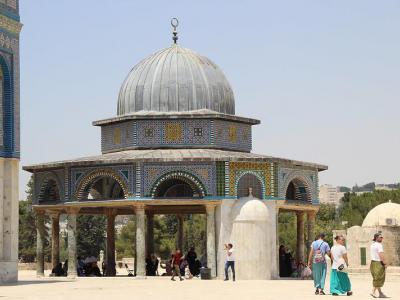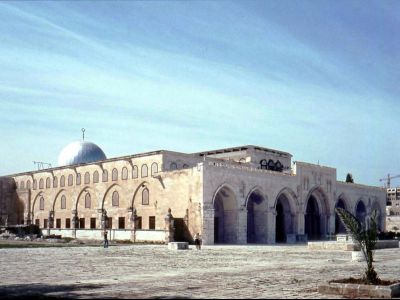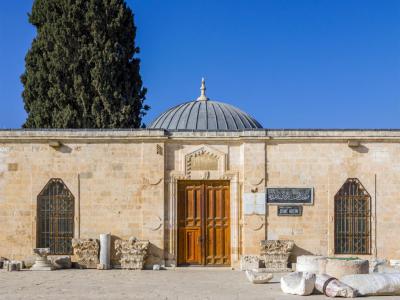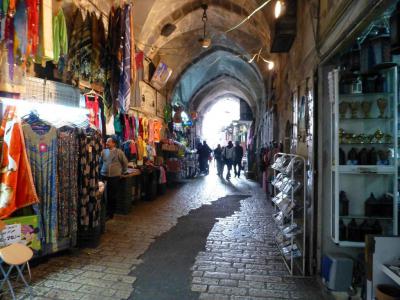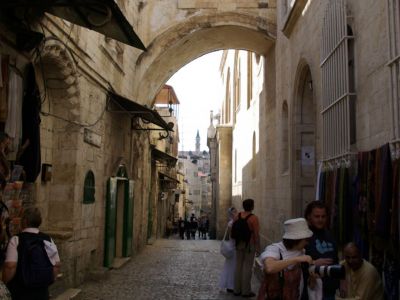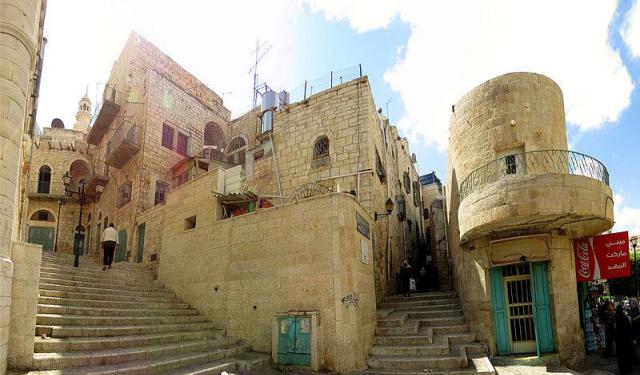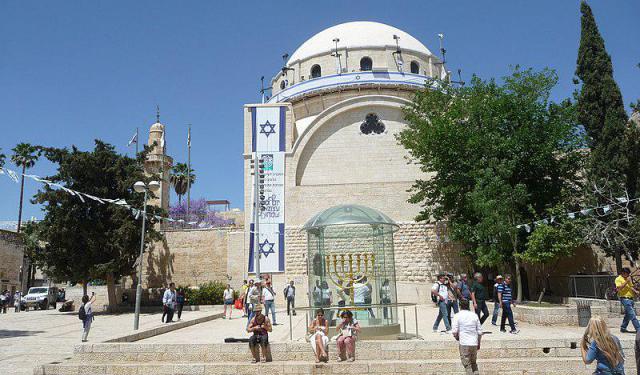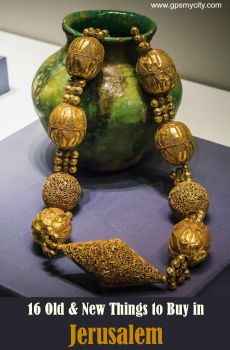
Muslim Quarter & Temple Mount Tour (Self Guided), Jerusalem
The largest, most populous and perhaps most chaotic of all Jerusalem’s quarters, the Muslim Quarter is worth exploring for its unique atmosphere. Spending a day here may take you back to a simpler time, but be prepared for many sights and sounds as you pass many vendors, stores and restaurants on your way from site to site.
Some of the city’s most interesting city gates (Damascus and Lion’s) are located in the area. Importantly, the Muslim Quarter is also the location of the Temple Mount, sacred to three great monotheistic religions, and the Dome of the Rock, probably the most easily recognizable landmark due to its enormous golden dome. Situated on the edge of the Old City, this extraordinary shrine was built over the rock where tradition says Prophet Muhammad ascended to heaven and Abraham attempted to sacrifice his son.
Christian visitors to Jerusalem will want to invest additional time visiting historic church sights like St. Anne’s (the birthplace of the Virgin Mary, according to Catholic tradition) and the Church of the Flagellation, held to be where Jesus took up his cross after being sentenced to death by crucifixion.
For a vibrant shopping experience, just inside of Damascus Gate is the gateway to the Arab Souk, where you can find trinkets, clothes, jewelry, plus many spices, sweets, raw meat, and other food.
Comprising these and more, our self-guided walking tour will help navigate your way through some of the Muslim Quarter’s most alluring attractions – so wear comfortable shoes and explore at your own pace.
Some of the city’s most interesting city gates (Damascus and Lion’s) are located in the area. Importantly, the Muslim Quarter is also the location of the Temple Mount, sacred to three great monotheistic religions, and the Dome of the Rock, probably the most easily recognizable landmark due to its enormous golden dome. Situated on the edge of the Old City, this extraordinary shrine was built over the rock where tradition says Prophet Muhammad ascended to heaven and Abraham attempted to sacrifice his son.
Christian visitors to Jerusalem will want to invest additional time visiting historic church sights like St. Anne’s (the birthplace of the Virgin Mary, according to Catholic tradition) and the Church of the Flagellation, held to be where Jesus took up his cross after being sentenced to death by crucifixion.
For a vibrant shopping experience, just inside of Damascus Gate is the gateway to the Arab Souk, where you can find trinkets, clothes, jewelry, plus many spices, sweets, raw meat, and other food.
Comprising these and more, our self-guided walking tour will help navigate your way through some of the Muslim Quarter’s most alluring attractions – so wear comfortable shoes and explore at your own pace.
How it works: Download the app "GPSmyCity: Walks in 1K+ Cities" from Apple App Store or Google Play Store to your mobile phone or tablet. The app turns your mobile device into a personal tour guide and its built-in GPS navigation functions guide you from one tour stop to next. The app works offline, so no data plan is needed when traveling abroad.
Muslim Quarter & Temple Mount Tour Map
Guide Name: Muslim Quarter & Temple Mount Tour
Guide Location: Israel » Jerusalem (See other walking tours in Jerusalem)
Guide Type: Self-guided Walking Tour (Sightseeing)
# of Attractions: 12
Tour Duration: 2 Hour(s)
Travel Distance: 2.1 Km or 1.3 Miles
Author: vickyc
Sight(s) Featured in This Guide:
Guide Location: Israel » Jerusalem (See other walking tours in Jerusalem)
Guide Type: Self-guided Walking Tour (Sightseeing)
# of Attractions: 12
Tour Duration: 2 Hour(s)
Travel Distance: 2.1 Km or 1.3 Miles
Author: vickyc
Sight(s) Featured in This Guide:
- Lions' Gate
- Pools of Bethesda
- Churches of St. Anne
- Dome of the Rock (Qubbat al-Sakhra)
- Dome of the Chain (Qubbat al-Silsilah)
- Al-Aqsa Mosque (Masjid al-Aqsa)
- Islamic Museum of Temple Mount
- Dome of the Ascension (Qubbat al-Miraj)
- Cotton Merchants' Gate and Market (Souk el-Qattanin)
- Convent of the Flagellation
- Ecce Homo Arch
- Beit Habad Street Market (Souk Khan El-Zeit)
1) Lions' Gate
This gate on Jerusalem's eastern ramparts is known by multiple names. While commonly referred to as the Lions' Gate due to the pair of beasts flanking the entrance, it is also called Saint Stephen's Gate after the first Christian martyr who was stoned to death outside the city. His tomb was originally located near the Damascus Gate but was later relocated here for the convenience of Christian pilgrims.
In Arabic, the gate is known as Bab al-Ghor ("Jordan Valley Gate") or "Gate of Our Lady Mary", since the Virgin is believed to have been born just inside. Yet another Arabic name is Meshikuli, which in more modern terms would mean "wicket" – a small opening in a wall – through which, back in the day, people could observe approaching enemies and, in case of attack, pour boiling oil or tar onto their heads.
Legend has it that the emblematic lions flanking the gateway (although one school of thought insists that they are panthers) were originally symbols of the Mamluk sultan Baybars I and were placed there by Suleiman the Magnificent in celebration of his successful campaign to rid the Holy Land of Crusaders. Another story suggests that Suleiman had the panthers installed after dreaming that he would be eaten by lions if he didn't rebuild Jerusalem's ramparts.
Despite its age and historical significance, the Lions' Gate remains remarkably well-preserved, having never undergone restoration. Visitors should be prepared for crowds, particularly on Fridays when Muslims gather for prayer at the nearby Al-Aqsa Mosque.
In Arabic, the gate is known as Bab al-Ghor ("Jordan Valley Gate") or "Gate of Our Lady Mary", since the Virgin is believed to have been born just inside. Yet another Arabic name is Meshikuli, which in more modern terms would mean "wicket" – a small opening in a wall – through which, back in the day, people could observe approaching enemies and, in case of attack, pour boiling oil or tar onto their heads.
Legend has it that the emblematic lions flanking the gateway (although one school of thought insists that they are panthers) were originally symbols of the Mamluk sultan Baybars I and were placed there by Suleiman the Magnificent in celebration of his successful campaign to rid the Holy Land of Crusaders. Another story suggests that Suleiman had the panthers installed after dreaming that he would be eaten by lions if he didn't rebuild Jerusalem's ramparts.
Despite its age and historical significance, the Lions' Gate remains remarkably well-preserved, having never undergone restoration. Visitors should be prepared for crowds, particularly on Fridays when Muslims gather for prayer at the nearby Al-Aqsa Mosque.
2) Pools of Bethesda
In the compound housing the Catholic Saint Anne's church, visitors can explore the ruins of the two historic Pools of Bethesda, constructed around 200 BC to supply water to the Temple. According to the Gospel of Saint John, these waters were believed to possess healing properties and were used by Jesus to cure a man who had been afflicted for thirty-eight years.
Excavations reveal the remains of the five porches mentioned in the Gospel, with nearby natural caves adapted as baths for the thousands of sufferers who sought healing during Roman times. Visitors can also observe the remnants of a 3rd-century temple to Serapis built by the Romans on the site, which was later replaced by a basilica during the Byzantine era.
As visitors follow the walkway around the pools, they can descend into the depths of a Roman cistern and explore the various archaeological features, with a detailed plan onsite providing guidance. Additionally, a small museum displays objects found during excavations, although it is typically open only by appointment.
Excavations reveal the remains of the five porches mentioned in the Gospel, with nearby natural caves adapted as baths for the thousands of sufferers who sought healing during Roman times. Visitors can also observe the remnants of a 3rd-century temple to Serapis built by the Romans on the site, which was later replaced by a basilica during the Byzantine era.
As visitors follow the walkway around the pools, they can descend into the depths of a Roman cistern and explore the various archaeological features, with a detailed plan onsite providing guidance. Additionally, a small museum displays objects found during excavations, although it is typically open only by appointment.
3) Churches of St. Anne (must see)
Inside the Lions' Gate, within a walled compound, stand two Churches of Saint Anne, both named after the mother of the Virgin Mary. The Greek Orthodox church, located nearest to the Lions' Gate, features a small cave-like chapel believed by Greek Orthodox tradition to be the site of Mary's birth. Downstairs, visitors can view the tombs of Mary's parents, Saints Anne and Joachim. The church welcomes visitors during specified hours, and a donation is typically expected.
Adjacent to the Greek Orthodox church is the 12th-century Greek Catholic church, open for visitation from Monday to Saturday. Considered one of the simplest yet most beautiful Crusader buildings in the region, it blends Romanesque architecture with Middle Eastern elements such as pointed arches and fluted fringe around the uppermost window (the Crusaders later introduced these very features to Europe). Inside, the unadorned columns and vaulting create a light and airy atmosphere. Due to the perfect acoustics ideal for choral singing, many pilgrim groups visit specifically to experience the remarkable reverberations of hymns sung within.
Descending stairs lead to the ancient crypt with mosaics and columns dating back to Byzantine times, where Catholic tradition places Mary's birth, though priests today refrain from asserting dogma on the matter.
Tips:
An intriguing aspect here is the asymmetrical design, which visitors can observe by counting the number of steps on each side. And, as an extra, there is an extremely beautiful church garden!
Adjacent to the Greek Orthodox church is the 12th-century Greek Catholic church, open for visitation from Monday to Saturday. Considered one of the simplest yet most beautiful Crusader buildings in the region, it blends Romanesque architecture with Middle Eastern elements such as pointed arches and fluted fringe around the uppermost window (the Crusaders later introduced these very features to Europe). Inside, the unadorned columns and vaulting create a light and airy atmosphere. Due to the perfect acoustics ideal for choral singing, many pilgrim groups visit specifically to experience the remarkable reverberations of hymns sung within.
Descending stairs lead to the ancient crypt with mosaics and columns dating back to Byzantine times, where Catholic tradition places Mary's birth, though priests today refrain from asserting dogma on the matter.
Tips:
An intriguing aspect here is the asymmetrical design, which visitors can observe by counting the number of steps on each side. And, as an extra, there is an extremely beautiful church garden!
4) Dome of the Rock (Qubbat al-Sakhra)
The Dome of the Rock stands as one of the most magnificent achievements of Islamic architecture, renowned for its golden dome, vibrant blue mosaics, and impeccable proportions. Commissioned by Caliph Abd al-Malik Ibn Marawan, the Dome was intended to assert Islam's significance alongside Judaism and Christianity, particularly in competition with the Church of the Holy Sepulchre.
Contrary to popular misconception, this structure is not a mosque but rather a shrine. It lacks features typical of mosques (such as a qibla wall and prayer hall); instead, it houses a sacred rock believed to be the site where Abraham intended to sacrifice his son. This rock protruded from the remains of Herod's Temple, and Abd al-Malik chose to commemorate it with the construction of the Dome.
The exterior is adorned with marble slabs and glazed green and blue tiles, featuring Koranic inscriptions, geometric patterns, and floral motifs. These designs, originally commissioned by Suleiman the Magnificent in the 1500s, have undergone various renovations over time.
In the 1960s, the dome was covered with anodized aluminum, replacing the original lead covering that had caused structural issues. This aluminum covering provided a lighter and more cost-effective solution compared to the gold that was once used but later melted down to settle the debts of a reckless caliph. Despite these changes, the Dome of the Rock remains an enduring symbol of Jerusalem.
Contrary to popular misconception, this structure is not a mosque but rather a shrine. It lacks features typical of mosques (such as a qibla wall and prayer hall); instead, it houses a sacred rock believed to be the site where Abraham intended to sacrifice his son. This rock protruded from the remains of Herod's Temple, and Abd al-Malik chose to commemorate it with the construction of the Dome.
The exterior is adorned with marble slabs and glazed green and blue tiles, featuring Koranic inscriptions, geometric patterns, and floral motifs. These designs, originally commissioned by Suleiman the Magnificent in the 1500s, have undergone various renovations over time.
In the 1960s, the dome was covered with anodized aluminum, replacing the original lead covering that had caused structural issues. This aluminum covering provided a lighter and more cost-effective solution compared to the gold that was once used but later melted down to settle the debts of a reckless caliph. Despite these changes, the Dome of the Rock remains an enduring symbol of Jerusalem.
5) Dome of the Chain (Qubbat al-Silsilah)
Adjacently east of Dome of the Rock, at the heart of the Temple Mount complex, the 7th-century Dome of the Chain is perhaps the most impressive smaller domes within the Haram. While its original purpose remains shrouded in mystery, it has been speculated to have served as a model for the Dome of the Rock or as the Treasury of the Temple Mount.
Legend has it that during the time of King Solomon, a chain hung from the dome's roof. If two individuals approached seeking resolution to a dispute, only the truthful and righteous one could grasp the chain; the dishonest would find it beyond their reach. Alternatively, those who dared to tell falsehoods while holding the chain risked being struck down by lightning. In Islamic tradition, this site is believed to be where Judgment Day will unfold during the "end of days", with a chain separating the righteous from the sinful.
Adorned with delicate blue and white tilework dating back to the Ottoman era (16th century), the interior of the dome exudes a sense of serenity. The mihrab, or prayer niche, found within the dome's single wall, reflects the distinctive Mamluk style, with lots of intricate stripey ablaq patterns, including the triple-colored arch which surmounts it, evoking almost flame-like motifs that captivate the eye.
Legend has it that during the time of King Solomon, a chain hung from the dome's roof. If two individuals approached seeking resolution to a dispute, only the truthful and righteous one could grasp the chain; the dishonest would find it beyond their reach. Alternatively, those who dared to tell falsehoods while holding the chain risked being struck down by lightning. In Islamic tradition, this site is believed to be where Judgment Day will unfold during the "end of days", with a chain separating the righteous from the sinful.
Adorned with delicate blue and white tilework dating back to the Ottoman era (16th century), the interior of the dome exudes a sense of serenity. The mihrab, or prayer niche, found within the dome's single wall, reflects the distinctive Mamluk style, with lots of intricate stripey ablaq patterns, including the triple-colored arch which surmounts it, evoking almost flame-like motifs that captivate the eye.
6) Al-Aqsa Mosque (Masjid al-Aqsa)
Masjid al-Aqsa, meaning "the Farthest Mosque", is simpler and less grandiose compared to the Dome of the Rock. Situated on the Temple Mount, it is believed to occupy the site of the first mosque built in Jerusalem in 638 AD to commemorate Mohammed's "night journey".
Throughout its history, Al-Aqsa has faced destruction and damage from earthquakes and various causes, prompting continuous rebuilding. During the Crusades, it served as the headquarters for the Crusaders, who converted the structure into a church, topping its dome with a cross, while the underground vaults housed Crusader horses, earning them the name Solomon's Stables. The military order of the Knights Templar, founded in 1118, took its name from the complex, which was referred to simply as the Templum by the Crusaders.
Under Saladin' rule, however, the Templar constructions were removed, and the mosque was restored to its original purpose. The mihrab was decorated, and a magnificent cedarwood minbar (pulpit) from Damascus, adorned with ivory and mother-of-pearl, was installed. Despite being destroyed in a fire in 1969, the mosque's beautiful mosaics, rose window, and original columns have endured.
Although much of the mosque's interior dates from the 20th century, it is not less beautiful, including seven aisles, 121 stained-glass windows, and marble columns. Non-Muslims are not permitted to enter without a guide, but they can still appreciate the exterior architecture as part of a visit to the Dome of the Rock.
Throughout its history, Al-Aqsa has faced destruction and damage from earthquakes and various causes, prompting continuous rebuilding. During the Crusades, it served as the headquarters for the Crusaders, who converted the structure into a church, topping its dome with a cross, while the underground vaults housed Crusader horses, earning them the name Solomon's Stables. The military order of the Knights Templar, founded in 1118, took its name from the complex, which was referred to simply as the Templum by the Crusaders.
Under Saladin' rule, however, the Templar constructions were removed, and the mosque was restored to its original purpose. The mihrab was decorated, and a magnificent cedarwood minbar (pulpit) from Damascus, adorned with ivory and mother-of-pearl, was installed. Despite being destroyed in a fire in 1969, the mosque's beautiful mosaics, rose window, and original columns have endured.
Although much of the mosque's interior dates from the 20th century, it is not less beautiful, including seven aisles, 121 stained-glass windows, and marble columns. Non-Muslims are not permitted to enter without a guide, but they can still appreciate the exterior architecture as part of a visit to the Dome of the Rock.
7) Islamic Museum of Temple Mount
Sited on the Temple Mount toward its Moroccan gate (or to the right of Al-Aqsa Mosque, this quaint museum stands as one of the country's oldest, holding a remarkable collection of rare artifacts spanning ten periods of Islamic history. From 16th-century copper soup kettles to coins, stained glass windows, and iron doors hailing from the era of Suleiman the Magnificent, the exhibits offer a fascinating glimpse into the rich heritage of the region.
Among the highlights are a cannon used to announce the end of Ramadan, a diverse array of weapons, along with unique items like a wax tree trunk and the charred remnants of a minbar crafted by Nur ad-Din Zangi in the 1170s, tragically destroyed in a 1969 incident involving an Australian tourist. Additionally, poignant relics such as the blood-stained clothing of 17 Palestinians who lost their lives during the 1990 Temple Mount riots serve as sobering reminders of the site's tumultuous history.
Also of note are the museum's 600 copies of the Qur'an, generously donated to the Al-Aqsa Mosque over the centuries by caliphs, sultans, scholars, and private individuals. Each copy is a unique treasure, varying in size, calligraphy, and ornamentation. One such copy is a handwritten Qur'ans attributed to the great-great-grandson of Muhammad, while another is written in ancient Kufic script dating back to the 8th-9th century. In addition, there is a massive Qur'an measuring 100 by 90 centimeters, dating to the 14th century.
Tip:
The admission fee also allow entry to the Al-Aqsa Mosque, contingent upon the prevailing security conditions at the time of visitation
Among the highlights are a cannon used to announce the end of Ramadan, a diverse array of weapons, along with unique items like a wax tree trunk and the charred remnants of a minbar crafted by Nur ad-Din Zangi in the 1170s, tragically destroyed in a 1969 incident involving an Australian tourist. Additionally, poignant relics such as the blood-stained clothing of 17 Palestinians who lost their lives during the 1990 Temple Mount riots serve as sobering reminders of the site's tumultuous history.
Also of note are the museum's 600 copies of the Qur'an, generously donated to the Al-Aqsa Mosque over the centuries by caliphs, sultans, scholars, and private individuals. Each copy is a unique treasure, varying in size, calligraphy, and ornamentation. One such copy is a handwritten Qur'ans attributed to the great-great-grandson of Muhammad, while another is written in ancient Kufic script dating back to the 8th-9th century. In addition, there is a massive Qur'an measuring 100 by 90 centimeters, dating to the 14th century.
Tip:
The admission fee also allow entry to the Al-Aqsa Mosque, contingent upon the prevailing security conditions at the time of visitation
8) Dome of the Ascension (Qubbat al-Miraj)
Aside from the iconic Dome of the Rock, the Temple Mount complex houses an array of nine other domes, each with its own unique significance. Among them stands the elegantly simple Dome of the Ascension, distinguished by its octagonal shape. While its original construction date by the Crusaders remains shrouded in mystery, records indicate a restoration in 1200 AD.
Legend has it that this humble dome marks the very spot where Jesus bid farewell to his disciples before ascending to heaven, with a small piece of bedrock purportedly bearing the imprint of his foot. While Arabic tradition refers to it as the "Dome of the Ascension" in honor of the Prophet Muhammad's legendary ascent to the Divine Throne from this site, scholars suggest that it was initially built as part of the Christian Templum Domini, likely serving as a baptistry.
An Arabic inscription dating back to 1200-1 offers further insight, describing its rededication as a waqf, or religious endowment, underscoring its evolving religious significance over the centuries.
Legend has it that this humble dome marks the very spot where Jesus bid farewell to his disciples before ascending to heaven, with a small piece of bedrock purportedly bearing the imprint of his foot. While Arabic tradition refers to it as the "Dome of the Ascension" in honor of the Prophet Muhammad's legendary ascent to the Divine Throne from this site, scholars suggest that it was initially built as part of the Christian Templum Domini, likely serving as a baptistry.
An Arabic inscription dating back to 1200-1 offers further insight, describing its rededication as a waqf, or religious endowment, underscoring its evolving religious significance over the centuries.
9) Cotton Merchants' Gate and Market (Souk el-Qattanin)
Known as the Souk el-Qattanin in Arabic, this covered market exudes an enchanting ambiance with its softly lit shops, creating an atmosphere that's arguably unmatched anywhere else in the Old City. Originally initiated by the Crusaders as a freestanding structure, its evolution took a significant turn in the first half of the 14th century when the Mamelukes linked it to the Haram ash-Sharif via the magnificent Cotton Merchants' Gate, offering a splendid view facing the Dome of the Rock. (Please note, access to the Haram via this gate is restricted to Muslims only, though non-Muslims may exit through it.)
Comprising around 50 shop units with living quarters above, the market also houses two exquisite bathhouses: the Hammam el-Ain, built by the Mamelukes in the 14th century, and the Hammam el-Shifa. Recently restored, the former now serves as a spa while the latter has been repurposed as an art gallery. Between these bathhouses lies the Khan Tankiz, a former hostel for merchants and pilgrims, which has also undergone restoration. Though not officially open to the public, a peek inside may be possible upon request.
Tip:
Just a stone's throw away from the market, on El-Wad Road, lies a small 16th-century public drinking fountain, or "sabil", one of six erected during the reign of Suleiman the Magnificent. Keep an eye out for this historical gem as you explore the area.
Comprising around 50 shop units with living quarters above, the market also houses two exquisite bathhouses: the Hammam el-Ain, built by the Mamelukes in the 14th century, and the Hammam el-Shifa. Recently restored, the former now serves as a spa while the latter has been repurposed as an art gallery. Between these bathhouses lies the Khan Tankiz, a former hostel for merchants and pilgrims, which has also undergone restoration. Though not officially open to the public, a peek inside may be possible upon request.
Tip:
Just a stone's throw away from the market, on El-Wad Road, lies a small 16th-century public drinking fountain, or "sabil", one of six erected during the reign of Suleiman the Magnificent. Keep an eye out for this historical gem as you explore the area.
10) Convent of the Flagellation
Belonging to the Franciscans, this compound encompasses the Chapel of the Flagellation, a striking yet simple structure crafted in the 1920s by the renowned Italian architect Antonio Barluzzi, known for his work on the Dominus Flevit Chapel on the Mount of Olives. Situated on the traditional site where Christ was scourged by Roman soldiers before his crucifixion, it marks the second station of the Via Dolorosa, following the Church of Saint Anne. Adorned with stained glass windows and an exquisite mosaic ceiling, the interior ingeniously depicts a circular pattern of thorns, subtly evoking the agonizing ordeal endured by Christ.
Across the courtyard lies the Chapel of the Condemnation, also originating from the early 20th century. Crowned by five elegant white domes, it stands atop the remnants of a medieval chapel, believed to be the location where Christ faced trial before Pontius Pilate. Noteworthy is the Roman-era floor adjacent to the building's western wall, constructed from large, striated stones designed to prevent animals' hooves from slipping—a glimpse into ancient ingenuity.
Nestled within the adjacent monastery buildings is the Studium Biblicum Franciscanum, a renowned institute dedicated to biblical, geographical, and archaeological studies. Complementing this scholarly endeavor is the Studium Museum, housing artifacts unearthed by the Franciscans during excavations across sites such as Capernaum, Nazareth, and Bethlehem. Highlights include Byzantine and Crusader relics, including fragments of frescoes from the Church of Gethsemane and a 12th-century crozier from the Church of the Nativity in Bethlehem, offering visitors a captivating journey through the rich tapestry of biblical history.
Across the courtyard lies the Chapel of the Condemnation, also originating from the early 20th century. Crowned by five elegant white domes, it stands atop the remnants of a medieval chapel, believed to be the location where Christ faced trial before Pontius Pilate. Noteworthy is the Roman-era floor adjacent to the building's western wall, constructed from large, striated stones designed to prevent animals' hooves from slipping—a glimpse into ancient ingenuity.
Nestled within the adjacent monastery buildings is the Studium Biblicum Franciscanum, a renowned institute dedicated to biblical, geographical, and archaeological studies. Complementing this scholarly endeavor is the Studium Museum, housing artifacts unearthed by the Franciscans during excavations across sites such as Capernaum, Nazareth, and Bethlehem. Highlights include Byzantine and Crusader relics, including fragments of frescoes from the Church of Gethsemane and a 12th-century crozier from the Church of the Nativity in Bethlehem, offering visitors a captivating journey through the rich tapestry of biblical history.
11) Ecce Homo Arch
The arch that spans the Via Dolorosa was originally built by the Romans in AD 70 to support a ramp against the Antonia Fortress, where Jewish rebels were barricaded. When the Romans rebuilt Jerusalem in AD 135 following the Second Jewish War, the arch was reconstructed as a monument to their victory. featuring two smaller arches flanking a large central bay. It is this central bay that spans the street just west of the entrance to the Lithostratos ("Pavement of Justice").
One of the side arches is still visible today, integrated into the interior of the neighboring Convent of the Sisters of Zion, which was built in the 1860s. Within the convent lie the remains of the ancient Pool of the Sparrow (Struthion), a reservoir that collected rainwater from rooftops. According to Christian tradition, it was on the stone pavement covering this pool that Pontius Pilate presented Jesus to the crowds, uttering the famous words "Ecce homo" ("Behold the man"). However, archaeological findings date the pavement to the 2nd century AD, during the reign of Hadrian, long after the time of Christ.
Marks scratched into the stone, visible within a railed section, are speculated by historians to have been made by Roman guards as a form of street game. Meanwhile, adjacent to the arch and the Third Station, on the north side of the street, a building belonging to the Greek Orthodox Patriarchate, (though not accessible to the public), bears a plaque identifying it as the Prison of Jesus and Barabas. This tradition was only established in 1911, however, and it is more likely that the structure was a stable associated with the Antonia Fortress.
One of the side arches is still visible today, integrated into the interior of the neighboring Convent of the Sisters of Zion, which was built in the 1860s. Within the convent lie the remains of the ancient Pool of the Sparrow (Struthion), a reservoir that collected rainwater from rooftops. According to Christian tradition, it was on the stone pavement covering this pool that Pontius Pilate presented Jesus to the crowds, uttering the famous words "Ecce homo" ("Behold the man"). However, archaeological findings date the pavement to the 2nd century AD, during the reign of Hadrian, long after the time of Christ.
Marks scratched into the stone, visible within a railed section, are speculated by historians to have been made by Roman guards as a form of street game. Meanwhile, adjacent to the arch and the Third Station, on the north side of the street, a building belonging to the Greek Orthodox Patriarchate, (though not accessible to the public), bears a plaque identifying it as the Prison of Jesus and Barabas. This tradition was only established in 1911, however, and it is more likely that the structure was a stable associated with the Antonia Fortress.
12) Beit Habad Street Market (Souk Khan El-Zeit)
Tucked just behind Damascus Gate, this colorful and fascinating market is a living testament to centuries of tradition, pulsating with culture along every cobbled lane. Stepping into its bustling labyrinth can feel like a step back in time, where familiar customs of the Western world may not always apply – but that's all part of the adventure.
At the more genuine and authentic Khan El-Zeit and El-Wad streets, vendors peddle spices, fruits, falafels, and other consumables for locals, alongside embroidered dresses, leather goods, and countless other handicrafts. As you venture further along Via Dolorosa, you'll encounter a mix of traditional souk shops and tourist-friendly stalls. Chain Street, an extension of David Street from the Christian Quarter, is lined with one shop after another selling souvenirs – the perfect spot to snag a unique memento if you're willing to hunt for it.
Prepare to flex your haggling skills as you peruse the stalls – it's all part of the souk experience, and you may just score some fantastic bargains. While it's busy at any time of day, evenings bring a trendy vibe to the souk, with eateries and pubs coming to life.
Tip:
Hit the market in the morning for the freshest baked goods, and if you're craving the best shawarma, head to the Muslim quarter of the souk – where they're known to be both delicious and budget-friendly.
At the more genuine and authentic Khan El-Zeit and El-Wad streets, vendors peddle spices, fruits, falafels, and other consumables for locals, alongside embroidered dresses, leather goods, and countless other handicrafts. As you venture further along Via Dolorosa, you'll encounter a mix of traditional souk shops and tourist-friendly stalls. Chain Street, an extension of David Street from the Christian Quarter, is lined with one shop after another selling souvenirs – the perfect spot to snag a unique memento if you're willing to hunt for it.
Prepare to flex your haggling skills as you peruse the stalls – it's all part of the souk experience, and you may just score some fantastic bargains. While it's busy at any time of day, evenings bring a trendy vibe to the souk, with eateries and pubs coming to life.
Tip:
Hit the market in the morning for the freshest baked goods, and if you're craving the best shawarma, head to the Muslim quarter of the souk – where they're known to be both delicious and budget-friendly.
Walking Tours in Jerusalem, Israel
Create Your Own Walk in Jerusalem
Creating your own self-guided walk in Jerusalem is easy and fun. Choose the city attractions that you want to see and a walk route map will be created just for you. You can even set your hotel as the start point of the walk.
Christian Quarter Walking Tour
One of the epicenters of worldwide Christianity, the Christian Quarter is the 2nd-largest of Jerusalem’s four ancient quarters. A fascinating place to stroll through, it covers the Old City’s northwestern part, just beyond Jaffa Gate – the traditional pilgrim’s entrance to Jerusalem and a prime destination for most visitors.
With its tangle of broad streets and winding, narrow alleys,... view more
Tour Duration: 1 Hour(s)
Travel Distance: 1.1 Km or 0.7 Miles
With its tangle of broad streets and winding, narrow alleys,... view more
Tour Duration: 1 Hour(s)
Travel Distance: 1.1 Km or 0.7 Miles
Bethlehem Walking Tour
Perched on a hill at the edge of the Judaean Desert, Bethlehem has been known to the world, for more than two millennia, as the birthplace of Jesus Christ. The “star of Bethlehem” as well as Christmas carols and hymns are firmly associated with this ancient city in the West Bank, Palestine, and thus, for some visitors, the bustle of a modern city may come as a surprise.
Undoubtedly, the... view more
Tour Duration: 1 Hour(s)
Travel Distance: 1.5 Km or 0.9 Miles
Undoubtedly, the... view more
Tour Duration: 1 Hour(s)
Travel Distance: 1.5 Km or 0.9 Miles
Following Steps of Jesus Walking Tour
Considered for centuries to be the center of the universe, Jerusalem is where the most famous figure in history, Jesus of Nazareth, fulfilled his divine mission by carrying a cross from the place of Pontius Pilate’s sentencing to Golgotha where he was crucified. This self-guided tour will retrace the steps of Jesus, allowing you to see what many consider some of the holiest places on our planet.... view more
Tour Duration: 2 Hour(s)
Travel Distance: 3.7 Km or 2.3 Miles
Tour Duration: 2 Hour(s)
Travel Distance: 3.7 Km or 2.3 Miles
Mount Scopus Walking Tour
Dotted with many sightseeing places, Mount Scopus – translating as the “Observation Mount” from Greek – is a great place to get views over the whole Old City of Jerusalem on a nice day. The mount has been of major strategic importance since Roman times, with forces setting up camp here prior to laying the siege that culminated in the final Roman victory over Jerusalem around 70 AD.... view more
Tour Duration: 1 Hour(s)
Travel Distance: 2.3 Km or 1.4 Miles
Tour Duration: 1 Hour(s)
Travel Distance: 2.3 Km or 1.4 Miles
Jewish Quarter Walking Tour
Entirely rebuilt in the 1980s after having been largely destroyed during the 1948 War, the Jewish Quarter is quite distinct from the rest of the Old City. Good signposting, spacious passageways, art galleries and a somewhat less buzzing atmosphere make the area a relaxing place to spend some time.
With its rebuilt residential buildings, some almost consider this area the "New... view more
Tour Duration: 1 Hour(s)
Travel Distance: 1.3 Km or 0.8 Miles
With its rebuilt residential buildings, some almost consider this area the "New... view more
Tour Duration: 1 Hour(s)
Travel Distance: 1.3 Km or 0.8 Miles
Armenian Quarter Walking Tour
Smaller and quieter than the Old City's other three quarters, the Armenian quarter contains a series of winding cobblestoned streets and alleyways teeming with people, shops, coffee stands, ceramic workshops and hookah bars. A city in miniature with distinct language, alphabet and culture, it has been in place since the 4th century, when Armenia adopted Christianity as a national religion.
... view more
Tour Duration: 1 Hour(s)
Travel Distance: 1.2 Km or 0.7 Miles
... view more
Tour Duration: 1 Hour(s)
Travel Distance: 1.2 Km or 0.7 Miles
Useful Travel Guides for Planning Your Trip
16 Uniquely Israel Things to Buy in Jerusalem
Modern day Jerusalem is a mosaic of neighborhoods, reflecting different historical periods, cultures, and religions. The influx of repatriates in recent years has made the cultural and artisanal scene of the city even more colourful and diverse. To find your way through Jerusalem's intricate...
The Most Popular Cities
/ view all
